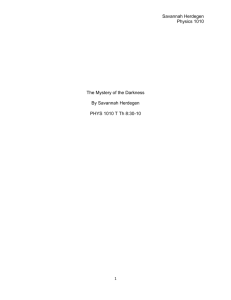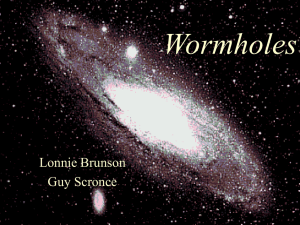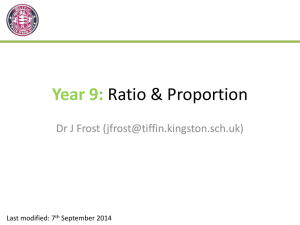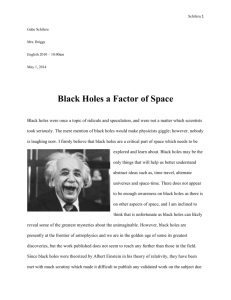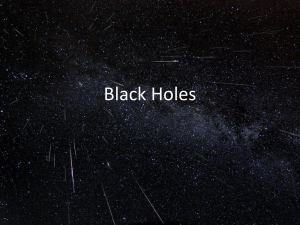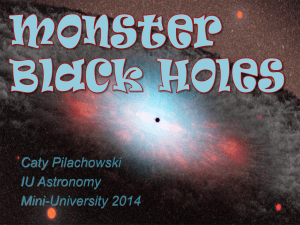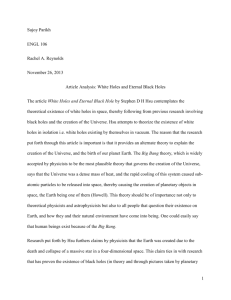PowerPoint Presentation - Black Holes
advertisement
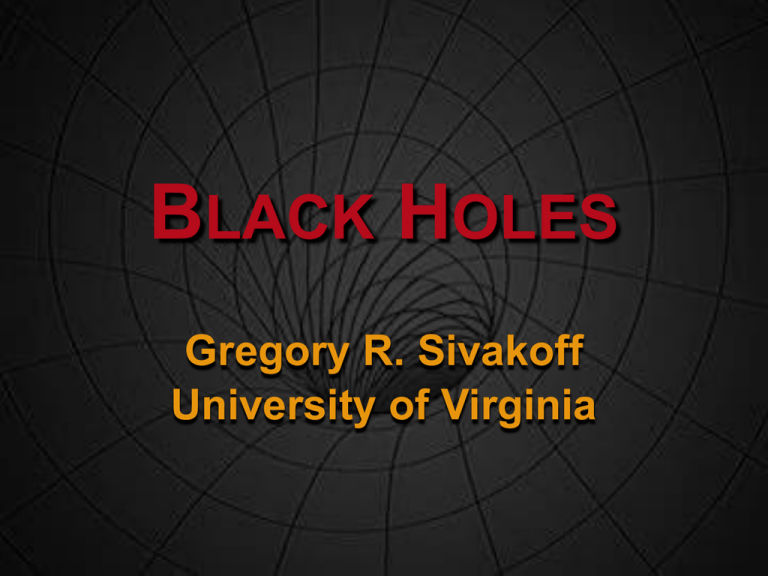
BLACK HOLES Gregory R. Sivakoff University of Virginia BLACK HOLES • What is a Black Hole? • How Do We Know Black Holes Exist? • Why Do We Study Black Holes? Understanding the GRAVITY of the Situation The gravitational force between two objects depends on • their Masses • their Separation Understanding the GRAVITY of the Situation 2 Gravity & Orbits Escape Velocity crush D =8000 miles M = 1025 kg Vesc = 25,000 miles/hour D = 800 miles M = 1025 kg Vesc = 79,000 miles/hour General Relativity: Mass Warps Spacetime • Space and time must be considered together • Gravity is really a warping of space and time • Denser objects warp spacetime more Warped Space-time Gravitational Lensing Gravitational Lensing Curving Light Escape Velocity crush (not to scale) D =8000 miles M = 1025 kg Vesc = 25,000 miles/hour D = Vesc = 2/3 inch M = 1025 kg Vesc = 186,000 miles/second The Event Horizon: Boundary of a Black Hole • Nothing inside the radius of the event horizon, not even light, can escape • Mass Radius • 1.8 miles for Sun • To the Moon for 400,000 Suns Knowledge About What Is Inside The Event Horizon • Charge (most likely neutral) • Spin • Non-spinning (unlikely) • Spinning • Mass (In units of the Sun) • Stellar mass (~3-30) • Supermassive (~100,000-billions) Black Holes Are Dense • Minimum density of a Solar Mass Black Hole is similar to that of an Atomic Nucleus • But, we believe black holes have (nearly?) infinite density Formation of Stellar Mass Black Holes Formation of Supermassive Black Holes • The first massive stars make large stellar mass black holes • Massive stellar mass black holes sink to center of a galaxy • Black holes mere and grow in dense stellar center How Do We Know Black Holes Exist? Cygnus X-1 Cygnus X-1: X-ray Image Cygnus X-1: Optical Image Supergiant Star 25 Solar Masses Cygnus X-1: Determining the Orbit Orbit Indicates 35 Solar Masses Cygnus X-1: The Whole System Black Hole 10 Solar Masses X-rays from orbitting material Supergiant 25 Solar Masses Most of optical light The Galactic Center 1 deg = 450 lyr Sagittarius (teapot) Galactic Center Next Slide 5 arcsec = 0.6 lyr The Galactic Center 3.6 Million Solar Masses in 70 Earth Radii Why Do We Study Black Holes • Exceptionally energetic • Stellar Mass Black Holes are remnants of massive stars • Supermassive black holes may interact with galaxy and affect how galaxies evolve Comparison of Energetics Gasoline 12 miles Nuclear Reactions To the Moon Falling onto a ~60 times farther Black Hole than the Moon ~ 50 millionths Hiroshima ~ 1 Hiroshima ~ 70 Hiroshimas Bright Shining Beacons Stellar Mass Black Holes: Massive Stellar Remnants We Are Made Of Star Dust Supermassive Black Holes Affect Galaxy Evolution WHAT IS A BLACK HOLE • Black Holes are extremely (infinitely?) dense concentrations of matter • They are so dense they create regions of space from which nothing can escape The strong effects of gravity lead to interesting behavior, but they do not suck things in • HOW DO WE KNOW BLACK HOLES EXIST? • We can study the space outside a Black Hole • By measuring the mass and density of an object, we can prove it is most likely a Black Hole WHY DO WE STUDY BLACK HOLES • Black Holes can lead to extremely energetic phenomena • Black Holes are the remnants of the massive stars whose dust we are made of • Supermassive Black Holes may affect how galaxies evolve

